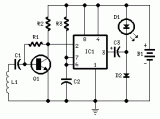Telephone related schematics
 A long time ago when telephones were so simple almost nothing could go amiss from an electrical point of view, Telecom operators installed surge protection on all telephone lines exposed to storm risks. Paradoxically, now that we are hooking up delicate and expensive equipment such as telephones filled with electronics, fax machines, (A)DSL modems, etc., this protection has disappeared....
[read more]
A long time ago when telephones were so simple almost nothing could go amiss from an electrical point of view, Telecom operators installed surge protection on all telephone lines exposed to storm risks. Paradoxically, now that we are hooking up delicate and expensive equipment such as telephones filled with electronics, fax machines, (A)DSL modems, etc., this protection has disappeared....
[read more]
 If you are lucky enough to have a big house, a large garden, and small children, this project just might interest you. It’s actually a telephone ringer capable of making any mains-powered device work from the ringer of your fixed line. With it, you will be able to control a high-powered siren or horn, as you like, in order to relay and amplify the low-level sound of your telephone (making it audible in a big house or in a large garden)! Alternatively, you can make a lamp light (or an indicator light) and so create a ‘silent ringer’ (helpful when small children are napping)....
[read more]
If you are lucky enough to have a big house, a large garden, and small children, this project just might interest you. It’s actually a telephone ringer capable of making any mains-powered device work from the ringer of your fixed line. With it, you will be able to control a high-powered siren or horn, as you like, in order to relay and amplify the low-level sound of your telephone (making it audible in a big house or in a large garden)! Alternatively, you can make a lamp light (or an indicator light) and so create a ‘silent ringer’ (helpful when small children are napping)....
[read more]
 This circuit was designed to detect when a call is incoming in a cellular phone (even when the calling tone of the device is switched-off) by means of a flashing LED. The device must be placed a few centimeters from the cellular phone, so its sensor coil L1 can detect the field emitted by the phone receiver during an incoming call....
[read more]
This circuit was designed to detect when a call is incoming in a cellular phone (even when the calling tone of the device is switched-off) by means of a flashing LED. The device must be placed a few centimeters from the cellular phone, so its sensor coil L1 can detect the field emitted by the phone receiver during an incoming call....
[read more]
 If you feel that somebody is tampering with your telephone line you might find this little circuit useful. It detects if there is another telephone connected to the line, if there is a short or an open line. Sound and a flashing light will tell you which is the current situation....
[read more]
If you feel that somebody is tampering with your telephone line you might find this little circuit useful. It detects if there is another telephone connected to the line, if there is a short or an open line. Sound and a flashing light will tell you which is the current situation....
[read more]
 This nifty little circuit lets you record your phone conversations automatically. The device connects to the phone line, your tape recorder's microphone input, and the recorder's remote control jack. It senses the voltage in the phone line and begins recording when the line drops to 5 volts or less....
[read more]
This nifty little circuit lets you record your phone conversations automatically. The device connects to the phone line, your tape recorder's microphone input, and the recorder's remote control jack. It senses the voltage in the phone line and begins recording when the line drops to 5 volts or less....
[read more]
 While talking to a distant subscriber on telephone, quite often we feel frustrated when the voice of the distant subscriber is so faint that it is barely intelligible. To overcome the problem, circuit of an inexpensive amplifier is presented here. It can be assembled and tested easily. There is no extra power source needed to power up the circuit, as it draws power from the telephone line itself. The amplifier will provide fairly good volume for the telephone conversation to be properly heard in a living room. A volume control is included to adjust the volume as desired....
[read more]
While talking to a distant subscriber on telephone, quite often we feel frustrated when the voice of the distant subscriber is so faint that it is barely intelligible. To overcome the problem, circuit of an inexpensive amplifier is presented here. It can be assembled and tested easily. There is no extra power source needed to power up the circuit, as it draws power from the telephone line itself. The amplifier will provide fairly good volume for the telephone conversation to be properly heard in a living room. A volume control is included to adjust the volume as desired....
[read more]
 Here is a simple transmitter that when connected to a phone line, will transmit anything on that line (execpt the dial tone) to any FM radio....
[read more]
Here is a simple transmitter that when connected to a phone line, will transmit anything on that line (execpt the dial tone) to any FM radio....
[read more]
 This circuit was designed to detect when a call is incoming in a cellular phone (even when the calling tone of the device is switched-off) by means of a flashing LED....
[read more]
This circuit was designed to detect when a call is incoming in a cellular phone (even when the calling tone of the device is switched-off) by means of a flashing LED....
[read more]
 You are asking how to connect up some lights so that when the phone rings, they flash. This is very useful in a situation were there is lots of noise and it is impossable to hear the phone, such as a workshop. Here is such a device. The ring detect part of this circuit came from...
[read more]
You are asking how to connect up some lights so that when the phone rings, they flash. This is very useful in a situation were there is lots of noise and it is impossable to hear the phone, such as a workshop. Here is such a device. The ring detect part of this circuit came from...
[read more]
 The normal telephone bell, at times (specially during night when one does not want to be disturbed), appears to be quite irritating. The circuit shown here converts the loud sounding bell into a soft and pleasing musical tone....
[read more]
The normal telephone bell, at times (specially during night when one does not want to be disturbed), appears to be quite irritating. The circuit shown here converts the loud sounding bell into a soft and pleasing musical tone....
[read more]
 Have you ever been using the modem or fax and someone else picks up the phone, breaking the connection? Well, this simple circuit should put an end to that. It signals that the phone is in use by lighting a red LED. When the phone is not in use, a green LED is lit. It needs no external power and can be connected anywhere on the phone line, even mounted inside the phone....
[read more]
Have you ever been using the modem or fax and someone else picks up the phone, breaking the connection? Well, this simple circuit should put an end to that. It signals that the phone is in use by lighting a red LED. When the phone is not in use, a green LED is lit. It needs no external power and can be connected anywhere on the phone line, even mounted inside the phone....
[read more]
 This circuit will allow you to place a phone call on hold and if you wish to have them listen to music while they are on hold....
[read more]
This circuit will allow you to place a phone call on hold and if you wish to have them listen to music while they are on hold....
[read more]
 This is a great intercom circuit that can be used in many ways. It uses 22V to operate and maybe it will work at a lower voltage (you can try it). For input/output it uses a loundspeaker (20-45 Ohm) on each side....
[read more]
This is a great intercom circuit that can be used in many ways. It uses 22V to operate and maybe it will work at a lower voltage (you can try it). For input/output it uses a loundspeaker (20-45 Ohm) on each side....
[read more]
 A very high quality intercom, which may also be used for room monitoring....
[read more]
A very high quality intercom, which may also be used for room monitoring....
[read more]